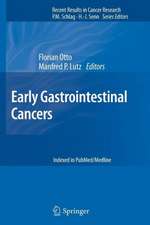Tumour Hypoxia: Spectrum Slovakia, cartea 1
Editat de Silvia Pastorekova, Juraj Kopaceken Limba Engleză Hardback – 14 noi 2012
Din seria Spectrum Slovakia
-
 Preț: 443.91 lei
Preț: 443.91 lei -
 Preț: 450.32 lei
Preț: 450.32 lei - 20%
 Preț: 616.47 lei
Preț: 616.47 lei - 23%
 Preț: 480.92 lei
Preț: 480.92 lei -
 Preț: 518.32 lei
Preț: 518.32 lei - 8%
 Preț: 425.58 lei
Preț: 425.58 lei -
 Preț: 265.41 lei
Preț: 265.41 lei -
 Preț: 364.44 lei
Preț: 364.44 lei -
 Preț: 351.75 lei
Preț: 351.75 lei - 19%
 Preț: 642.42 lei
Preț: 642.42 lei - 8%
 Preț: 422.91 lei
Preț: 422.91 lei - 23%
 Preț: 280.48 lei
Preț: 280.48 lei - 20%
 Preț: 412.34 lei
Preț: 412.34 lei - 6%
 Preț: 278.48 lei
Preț: 278.48 lei - 7%
 Preț: 293.66 lei
Preț: 293.66 lei -
 Preț: 389.18 lei
Preț: 389.18 lei -
 Preț: 369.83 lei
Preț: 369.83 lei -

Preț: 652.93 lei
Preț vechi: 687.30 lei
-5% Nou
Puncte Express: 979
Preț estimativ în valută:
124.95€ • 129.97$ • 103.16£
124.95€ • 129.97$ • 103.16£
Carte disponibilă
Livrare economică 24 martie-07 aprilie
Livrare express 07-13 martie pentru 58.71 lei
Preluare comenzi: 021 569.72.76
Specificații
ISBN-13: 9783631639917
ISBN-10: 3631639910
Pagini: 556
Dimensiuni: 172 x 242 x 27 mm
Greutate: 1.05 kg
Ediția:Nouă
Editura: Peter Lang Gmbh, Internationaler Verlag Der W
Seria Spectrum Slovakia
ISBN-10: 3631639910
Pagini: 556
Dimensiuni: 172 x 242 x 27 mm
Greutate: 1.05 kg
Ediția:Nouă
Editura: Peter Lang Gmbh, Internationaler Verlag Der W
Seria Spectrum Slovakia
Cuprins
Contents: Norma Masson/Peter J. Ratcliffe: Oxygen sensing by HIF hydroxylases - Thomas M.F. Connor/Patrick H. Maxwell: VHL inactivation - Carine Michiels: Oncogenic activation of HIF pathway - Katarzyna J. Nytko/Daniel P. Stiehl/Roland H. Wenger: PHD oxygen sensor function and antioxidants - Agnieszka Loboda/Halina Was/Urszula Florczyk/Alicja Jozkowicz/Jozef Dulak: Hypoxia-driven angiogenesis and other modes of blood vessel formation in tumours - Erik Olai Pettersen: Cell cycle alterations by hypoxic microenvironment - Eoin P. Cummins/Susan F. Fitzpatrick/Cormac T. Taylor: The role of NF-?B in hypoxia-induced gene expression - Roman Hrstka/Petr Müller/Philip J. Coates/Borivoj Vojtesek: Hypoxia and p53 - Thomas Kietzmann: Hypoxia: a powerful signal to induce metabolic changes - Eliska Svastova/Silvia Pastorekova: Hypoxia, regulation of pH and cell migration/invasion - Agnes Görlach: Reactive oxygen species and hypoxia signaling - Olga Krizanova: Calcium transport in hypoxia - Sandra Winning/Joachim Fandrey: HIF and inflammation - Martina Takacova/Tereza Goliasova/Juraj Kopacek: Hypoxia and oncogenic viruses - Sarah Peeters/Philippe Lambin/Ludwig Dubois: Noninvasive hypoxia imaging - Bart Reymen/Philippe Lambin: Hypoxia, hypoxia response and conventional anti-cancer therapy - Kaye J. Williams/Stephanie R. McKeown: Targeting hypoxic cells with bioreductive prodrugs - Annamaria Rapisarda/Nicole Fer/Giovanni Melillo: Targeting the hypoxic tumour microenvironment: a unique role for HIF-1 inhibitors - Claudiu T. Supuran: New drugs interfering with pH regulation in hypoxic tumours.













